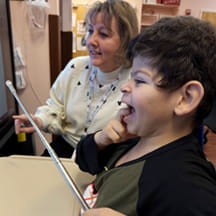Ivy Roger made history by the time she was 7 years old. Confined to a wheelchair because of her cerebral palsy, she made the trip from a small town in Australia to St. Louis Children's Hospital, where she became the 4,000th patient there to receive a specialized spine surgery that improves mobility issues.
"I'm looking forward to just step over to Mommy and give her a hug," Ivy said before her surgery.
Within weeks of her two-and-a-half-hour surgery, Ivy took her first steps. "I feel pretty weird, and pretty proud of myself," she said at the time."She took 100 steps down the hallway," said Michelle Roger, Ivy's mom. "To see her do that with so little support and we're only five weeks from surgery, it's blowing my mind. It's way more than we expected."
Life-changing surgery
Families like Ivy's come to St. Louis Children's Hospital from all around the country—and from nearly 80 countries around the world—for this surgery from T.S. Park, M.D., a neurosurgeon at St. Louis Children's Hospital and Washington University School of Medicine. Park pioneered—and continues to perfect—the surgery, called selective dorsal rhizotomy (SDR). The goal of the procedure is to improve gross motor function, particularly to help patients walk, by reducing spasticity.
Spasticity is the stiffness in the muscles experienced by patients with cerebral palsy, caused by abnormal communication among the spinal cord, nerves and muscles. This spasticity inhibits a child's muscle growth, which causes muscle contractures and orthopedic deformities. The SDR surgery corrects muscle spasticity by cutting the nerve rootlets in the spinal cord that are sending abnormal signals to the muscles.
"The SDR surgery can remove the spasticity permanently and completely," says Park, who has now performed more than 4,000 SDR surgeries, about 250 of them each year. "By removing the spasticity, we can help them walk better and maintain that throughout their lives."
Park studied under the procedure's pioneers in the 1970s, brought it to the U.S. in 1986 and customized it to be more effective in 1991. His minimally invasive SDR removes less spinal bone than previous procedures, typically resulting in fewer spine and back complications later in life.
Giving the gift of walking
Depending on the patient's condition, the surgery can result in moving from wheelchair dependency to walking with canes or even the ability to walk, run and play without any assistance. Park says the ideal age for the surgery is 2 to 3 years old, although he has performed the surgery on about 150 adult and adolescent patients.
Today, he still hears from some of his earlier patients who are living lives they never could have lived without the surgery and Park's care.
"I get a lot of emails and see Facebook posts saying, ‘I had the surgery 25 years ago, and I have a family now,'" says Park. "I feel blessed to do this."
Like Park, Ivy and her mom feel blessed. Today, they are back in Australia with Ivy continuing her physical therapy and getting stronger. She already has plans for some of the things she'll do now, thanks to her surgery.
"Now that I'm walking, I could snatch Mommy's phone off the table while she's sleeping," predicts Ivy in a whisper. "And I could creep back to my room, where my brother and sister are sleeping, and I'd say, 'Wake up! Wake up! I've got Mommy's phone. We can watch YouTube.'"


